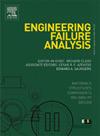金属层材料性能对金属层压板抗皱性能的影响
IF 4.4
2区 工程技术
Q1 ENGINEERING, MECHANICAL
引用次数: 0
摘要
金属层压板在塑性成形过程中容易起皱,不同金属层间的力学响应差异导致起皱机理的复杂性。然而,了解这些差异如何影响抗皱性能可以提高层压板的抗皱性能。因此,本研究采用吉田屈曲试验和有限元法建立了基于宏观形态特征的抗皱性评价指标。此外,还分析了不同金属层材料参数(弹性模量E、泊松比μ、强度系数K、硬化指数n)对层压板抗皱性能的影响。研究表明,增大E、μ和K参数或减小n均能提高金属层合板的整体抗皱性能。此外,通过正交试验方法进一步揭示了各参数对抗皱性的敏感性。结果表明,基材性能对抗皱性能的敏感性高于复层材料性能。灵敏度层次遵循n >;K比;E比;μ。同时,得到了抗皱性能的最佳参数组合。研究结果为金属层合板的优化设计和制造提供了理论依据和指导。本文章由计算机程序翻译,如有差异,请以英文原文为准。

Effect of metal layer material properties on the metal laminate wrinkle resistance
Metal laminates are prone to wrinkling in the plastic forming, and the mechanical response differences between different metal layers lead to the complexity of the wrinkling mechanism. However, understanding how these differences affect wrinkle resistance can improve the laminate anti-wrinkle properties. Therefore, this study established evaluation indicators for wrinkle resistance based on macroscopic morphological characteristics using the Yoshida Buckling test and the finite element method. Furthermore, the influence of material parameters of different metal layers (including elastic modulus E, Poisson ratio μ, strength coefficient K, and hardening index n) on the laminate wrinkle resistance was analyzed. The study indicates that increasing the parameters E, μ, and K or decreasing n can enhance the overall wrinkle resistance on metal laminates. In addition, orthogonal test methods further reveal the sensitivity of each parameter to wrinkle resistance. The results demonstrate that the material properties of the base layer exhibit higher sensitivity to wrinkling resistance than those of the cladding layer. The sensitivity hierarchy follows n > K > E > μ. At the same time, the optimal parameter combination for wrinkle resistance is obtained. The research result provides a theoretical basis and guidance for the optimal design and manufacture of metal laminates.
求助全文
通过发布文献求助,成功后即可免费获取论文全文。
去求助
来源期刊

Engineering Failure Analysis
工程技术-材料科学:表征与测试
CiteScore
7.70
自引率
20.00%
发文量
956
审稿时长
47 days
期刊介绍:
Engineering Failure Analysis publishes research papers describing the analysis of engineering failures and related studies.
Papers relating to the structure, properties and behaviour of engineering materials are encouraged, particularly those which also involve the detailed application of materials parameters to problems in engineering structures, components and design. In addition to the area of materials engineering, the interacting fields of mechanical, manufacturing, aeronautical, civil, chemical, corrosion and design engineering are considered relevant. Activity should be directed at analysing engineering failures and carrying out research to help reduce the incidences of failures and to extend the operating horizons of engineering materials.
Emphasis is placed on the mechanical properties of materials and their behaviour when influenced by structure, process and environment. Metallic, polymeric, ceramic and natural materials are all included and the application of these materials to real engineering situations should be emphasised. The use of a case-study based approach is also encouraged.
Engineering Failure Analysis provides essential reference material and critical feedback into the design process thereby contributing to the prevention of engineering failures in the future. All submissions will be subject to peer review from leading experts in the field.
 求助内容:
求助内容: 应助结果提醒方式:
应助结果提醒方式:


